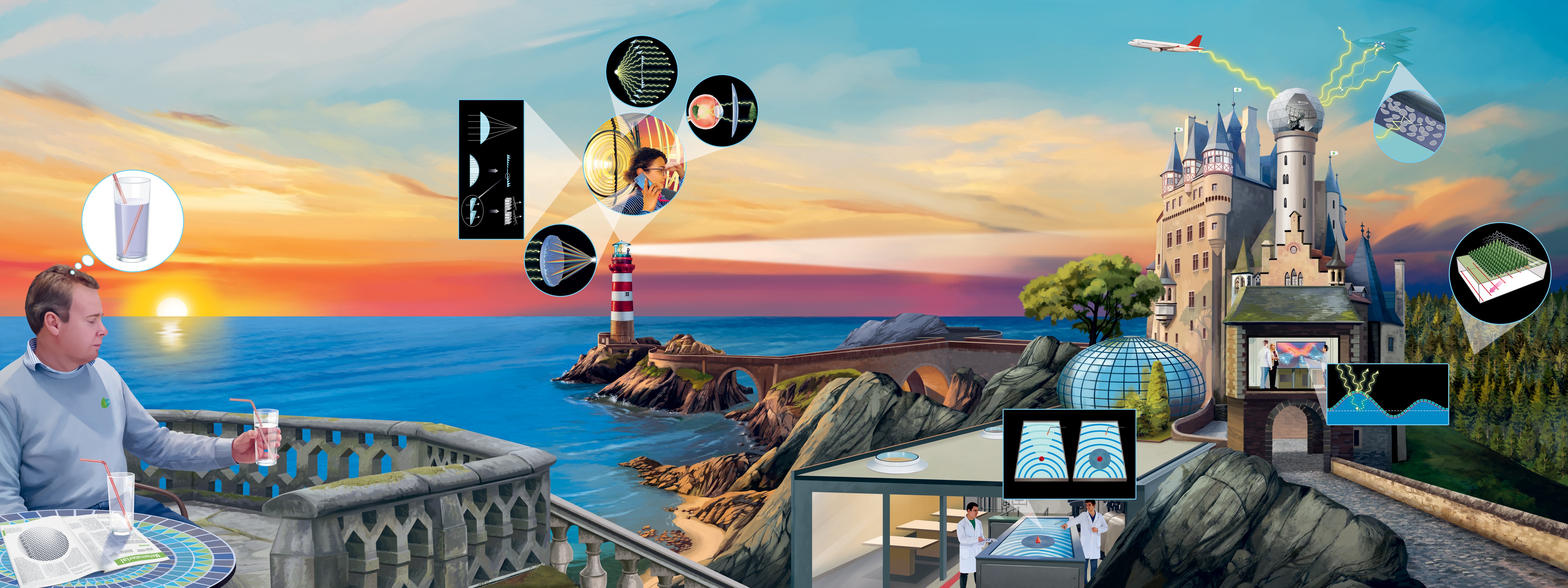Abracadabra
Using waves to change perception thanks to their manipulability
Technical devices make use of the fact that waves can be reflected, refracted, bent at an obstacle, etc. The
controlled use of these properties is called manipulation. Could we even manipulate waves to make objects invisible
– almost like in Harry Potter?

Bending Straws
A straw in a glass of water appears broken and displaced – in a very specific direction. It would be surprising if the straw appeared to be broken in the other direction, i.e. ‘negatively’. This case does not exist in nature. However, researchers are working on artificial materials (metamaterials) that, due to their structure, manipulate waves in such a way that they are refracted in almost all directions – even unnatural and negative ones. In this way, it would in principle be possible to guide light around objects and thus make them invisible.
Metamaterials consist of units (‘building blocks’) of common materials. However, they are arranged in special, usually regularly recurring patterns. Due to their components and structure, each unit has its own effect on an arriving wave and determines how the wave is refracted, among other things. All units together determine the properties of the metamaterial. Since the units are much smaller than the wavelength of the wave to be influenced, the metamaterial appears to the wave as a mass with uniform new, unnatural properties.
Bundling Light
Light is refracted by optical lenses and focused in one point or dispersed in space. We know this from eyeglass lenses that correct a deformation of the eyeball so that an image is focused on the retina. This gives us sharp vision.
The stronger the vision defect to be corrected, the thicker, heavier and more curved the optical lens is. What is unattractive for spectacles is a problem for the operation of lighthouses. The physicist A. J. Fresnel therefore developed a special lens by reducing it to its most important feature: the curved surface, because only this determines how light is refracted. Thus he obtained a narrow, steplike lens that follows the curvature of a conventional lens. To capture even more light for use in lighthouses, additional prism-shaped rings can be arranged around the lens.
Metalenses try to be even more efficient with even less material. For this purpose, nanometresized units of grooves and metallic pillars form a flat surface. These structures deflect light, breaking it down into its colour components. In order to obtain white light behind the lens again, the nanostructures delay the passage of each colour component differently so that they come together again when they emerge and converge at exactly the right angle towards a focal point. Metalenses thus achieve at least as much precision as conventional lenses. But because they are extremely thin, they could revolutionise technical devices such as cameras.
Concealing Objects
Stealth technologies make things invisible or harder to detect. The angular, smooth shape of stealth aircraft prevents radar waves from being reflected back to the sender; special coatings ‘swallow’ waves; and suitable devices cancel reflections with an oppositely oscillating wave – just like noise-cancelling headphones cancel ambient noise.
For true invisibility, however, light must be directed entirely around an object. Since this path is longer than the direct one, the redirected waves would have to be faster in order to arrive behind the object at the same time as the direct ones – otherwise visible lighting effects would occur. However, it is impossible to go faster than the speed of light, so an invisibility cloak working in full daylight like Harry Potter’s is probably impossible for us to create.
Sound waves in water, however, can travel at different velocities, so an object can be hidden from ultrasonic waves under water. A metamaterial surrounds the object and guides the sound waves through its structure so quickly that they arrive behind the object at the same time as the waves that have not been diverted.
A metafoil made of wafer-thin gold structures can conceal a tiny object and make it seem as if it were not there. The foil, which coats the object like a skin, manipulates arriving light in such a way that a flat mirror can be seen instead of the object.
Could earthquake waves be manipulated in such a way that their destructive potential is reduced? Experiments show that increasingly taller rows of trees (metaforest) mitigate weak surface waves (like those from traffic) or divert them into deeper soil layers. This inspired the development of metafoundations in order to absorb vibrations under important structures such as nuclear power plants.